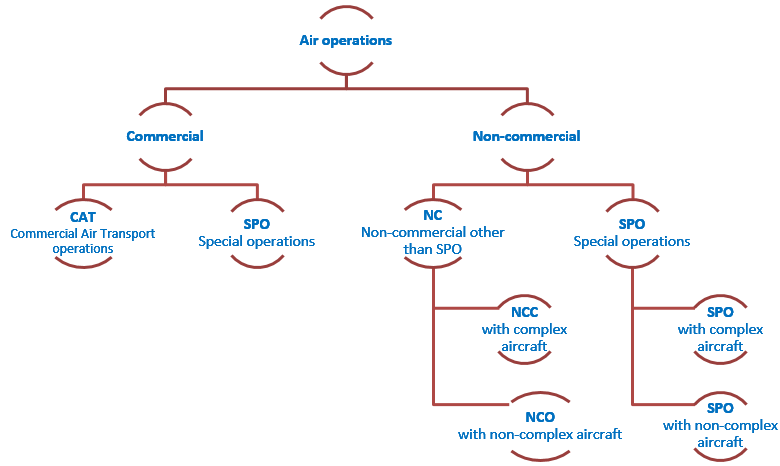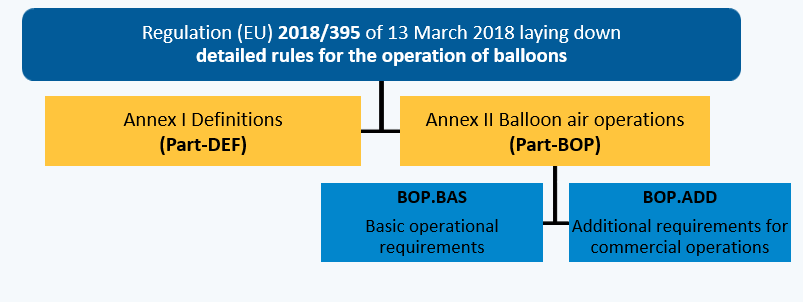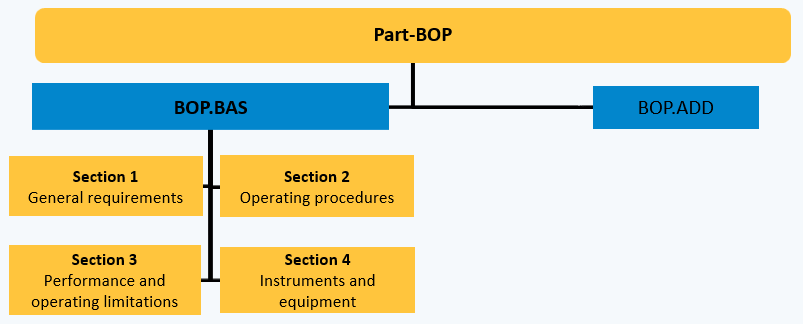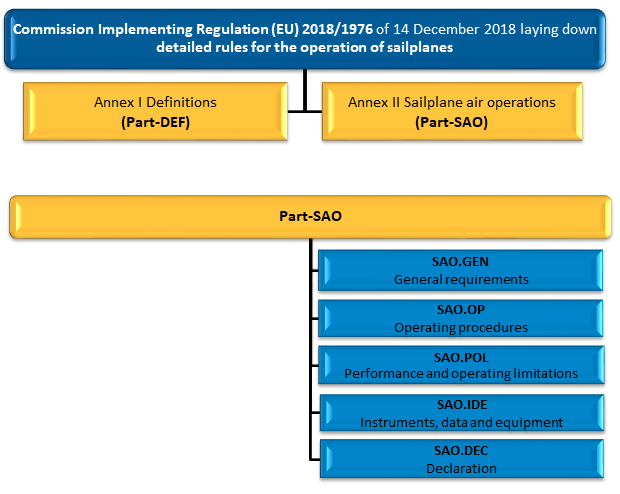Operator classification
EASA applied the classification shown below to develop a different set of technical rules for air operations (e.g. CAT, NCC, NCO, SPO operations), taking into account the principle of proportionality and the need to have different safety levels. The safety levels were based on a risk hierarchy, and the rules for non-commercial operations were developed to achieve the following objectives:
- to maintain a proportionate level of safety depending on the complexity of the aircraft;
- to guarantee sufficient flexibility and efficiency for operators and authorities;
- to be compliant with the ICAO standards and recommended practices (SARPs) of Annex 6 Part II and Part III Sections III as far as feasible; and
- to ensure proportionate rules between NCO and NCC operations;
- to be consistent with the rules of the other Annexes to the AIR OPS Regulation.

Applicable OPS rules for NCO and NCC operators
| Rule applicability | NCO operator | NCC operator |
| Annex I: Definitions | containing definitions of terms | containing definitions of terms |
| Annex II: Part-ARO | ||
| Annex III: Part-ORO | partly applies to NCC | |
| Annex IV: Part-CAT | ||
| Annex V: Part-SPA | only if a SPA operation is needed | only if a SPA operation is needed |
| Annex VI: Part-NCC | technical rules for NCC operations | |
| Annex VII: Part-NCO |
|
|
| Annex VIII: Part-SPO |
Difference between NCO and NCC
EASA developed two different sets of rules for non-commercial operations, depending on the complexity of the aircraft:
- for the operation of non-complex aircraft, basic safety rules apply (Part-NCO). The term NCO stands for non-commercial operations with other-than-complex aircraft;
- for the operation of complex aircraft, more complex safety rules apply (Part-NCC and partly Part-ORO), particularly taking into account that complex aircraft may carry a larger number of passengers and usually require professional teams for their operations. The term NCC stands for non-commercial operations with complex motor-powered aircraft.
The term ‘complex motor-powered aircraft’ is defined in Regulation (EU) 2018/1139 as follows:
“‘complex motor-powered aircraft’ shall mean:
(i) an aeroplane:
- with a maximum certificated take-off mass exceeding 5700 kg, or
- certificated for a maximum passenger seating configuration of more than nineteen, or
- certificated for operation with a minimum crew of at least two pilots, or
- equipped with (a) turbojet engine(s) or more than one turboprop engine, or
(ii) a helicopter certificated:
- for a maximum take-off mass exceeding 3175 kg, or
- for a maximum passenger seating configuration of more than nine, or
- for operation with a minimum crew of at least two pilots, or
(iii) a tilt rotor aircraft;”
Different from this definition, ICAO defines a large aeroplane (in Annex 6 Part II) as ‘an aeroplane of a maximum certificated take-off mass of over 5700 kg’.
Alleviation for complex motor-powered aeroplanes with turboprop engines
The definition of a complex motor-powered aeroplane deviates from the ICAO definition of a large aeroplane insofar as a complex motor-powered aeroplane includes expressively a multi-engine turboprop aeroplane with a maximum take-off mass at or below 5,7 t. Under ICAO SARPs, such an aeroplane is classified as a small aeroplane.
The AIR OPS Regulation (EU) 965/2012 contains an alleviation in this sense: Article 6.8 states that operators of complex motor-powered aeroplanes with an MCTOM at or below 5700 kg, equipped with turboprop engines, involved in non-commercial operations, shall operate those aircraft in accordance with Annex VII (Part-NCO).
Definitions of ELA aircraft introduced by Regulation (EU) 800/2013
Reg. (EU) No 800/2013 adds new definitions in Annex I, Definitions:
“‘ELA1 aircraft’ means the following manned European Light Aircraft:
- an aeroplane with a Maximum Take-off Mass (MTOM) of 1200 kg or less that is not classified as complex motor-powered aircraft;
- a sailplane or powered sailplane of 1200 kg MTOM or less;
- a balloon with a maximum design lifting gas or hot air volume of not more than 3400 m 3 for hot air balloons, 1050 m 3 for gas balloons, 300 m 3 for tethered gas balloons.
‘ELA2 aircraft’ means the following manned European Light Aircraft:
- an aeroplane with a Maximum Take-off Mass (MTOM) of 2000 kg or less that is not classified as complex motor-powered aircraft;
- a sailplane or powered sailplane of 2000 kg MTOM or less;
- a balloon;
- a Very Light Rotorcraft with a MTOM not exceeding 600 kg which is of a simple design, designed to carry not more than two occupants, not powered by turbine and/or rocket engines; restricted to VFR day operations.”
New regulation on balloon operations
In March 2018, the European Commission published Regulation (EU) No 2018/395 on the operation of balloons, establishing less complex provisions, proportionate to the complexity and risk of such operations.
The Air Ops Regulation (EU) 965/2012 was also amended by deleting all the requirements applicable to balloon operations (in the amending regulation (EU) No 2018/394).
Shortly after, EASA published the related Decisions containing AMC and GM to the new regulations.
The Balloon Rule Book – Easy Access Rules, containing both the Commission Regulation (EU) 2018/395 and the EASA AMC and GM, is also available for download. For now, this book contains only the air operations rules for balloons, but in the future, it will include also the licensing rules for balloons and the airworthiness rules for balloons.
The new regulation on balloon operations will apply from 8 April 2019. Until then, the Member States will continue to apply the current rules.
Regulation (EU) 2018/395 structure:


 For more information about the new operational rules for balloons, we invite you to read the interview with Jan Boettcher, the EASA Air Operations expert.
For more information about the new operational rules for balloons, we invite you to read the interview with Jan Boettcher, the EASA Air Operations expert.
Air operations with sailplanes
Commission Implementing Regulation (EU) 2018/1976 on sailplane operations was published by the Commission on 20 December 2018.
The associated EASA AMC and GM were published on 28 January 2019 on the EASA Official Publications page.
The sailplane rules were extracted from Reg. (EU) No 965/2012 on air operations (except for the authority requirements, which remained in Part-ARO) and published in a new, separate regulation addressing only the air operations with sailplanes. The new regulation establishes simpler rules, proportionate to the complexity and risk level of these operations, and reduces the regulatory burden for sailplane pilots and operators.
Regulation (EU) 2018/1975 amends Regulation (EU) No 965/2012 on air operations by removing all the requirements applicable to sailplanes operations.
Regulations (EU) 2018/1975 and (EU) 2018/1976 become applicable as of 9 July 2019.
An Easy Access Rules Book for Sailplanes will be available soon. Check Easy Access Rules regularly.
Structure of Regulation (EU) 2018/1976:

Safety Information Bulletin (SIB) on blood alcohol concentration limits for GA pilots
A new SIB was published in April 2018 for GA pilots, aeroclubs, pilot training organisations and competent authorities, containing details about the effect of alcohol consumption on the flying capabilities, as well as a number of recommendations.
The SIB can be downloaded from this page.